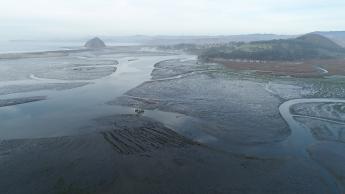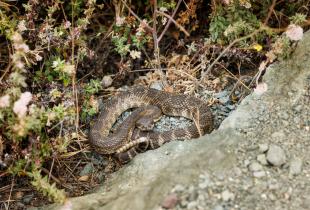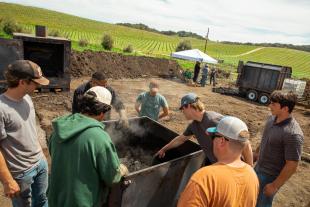Cal Poly Study: Large-Scale Loss of Eelgrass in Morro Bay Estuary May Cause Widespread Erosion

The large-scale loss of eelgrass in the Morro Bay estuary may be causing widespread erosion, according to a new Cal Poly study.
In recent years, Morro Bay’s iconic eelgrass beds, which provide the estuary’s primary living habitat, experienced a massive die-off, declining more than 90 percent since 2007. Efforts to restore the eelgrass have had mixed success in many parts of the bay, and this seagrass is now only found near the harbor mouth and sporadically in other regions of the estuary.
Seagrass systems are found throughout the world and provide many ecosystem services including fish nursey habitats, forage for migratory birds, nutrient cycling, carbon storage and sediment stabilization.
“The loss of eelgrass in the Morro Bay estuary is analogous to the loss of trees in a rainforest,” said Ryan Walter, lead author and a Cal Poly physics professor. “Not only do you lose the plants, but you also lose all of the services that they provide for the entire ecosystem.”
Eelgrass is a flowering underwater plant with quarter-inch-wide leaves that can grow up to lengths of 3 feet. Its beds are always completely submerged, and their roots, or rhizomes, anchor the grass to sandy or muddy bottoms. By slowing down currents and decreasing wave forces, seagrasses help stabilize sediment and prevent erosion.
Over the last century, the bay has been building up sediment quickly and is dredged annually, with the Army Corps of Engineers doing a more extensive dredging of the harbor about every five or six years.
“These erosional changes are sizeable considering that Morro Bay, a modified estuary, has historically suffered from accelerated sedimentation,” Walter said.
Globally, seagrasses in the nearshore coastal environment are among the most threatened ecosystems on the planet.
Generally, losses of seagrasses can lead to increased shoreline and estuarine erosion. On the other hand, it is possible that the erosion in Morro Bay may create new opportunities for seagrass recovery by increasing the depth and suitable habitat for eelgrass in certain locations.
Recent restoration attempts by the Morro Bay National Estuary Program have been successful, and there is evidence of a partial recovery in portions of the bay. Tracking changes in sediment in places like Morro Bay will become increasingly important as climate change is expected to drive sea level increases and shoreline change.
“Morro Bay is an estuary of national importance that is under transition with systemwide eelgrass loss, subsequent sediment loss, and now some signs of eelgrass recovery,” said coauthor Jennifer O’Leary, a former California Sea Grant extension specialist. “Understanding the dramatic changes in Morro Bay can help identify important factors for management and conservation of eelgrass-dominated systems globally.”




